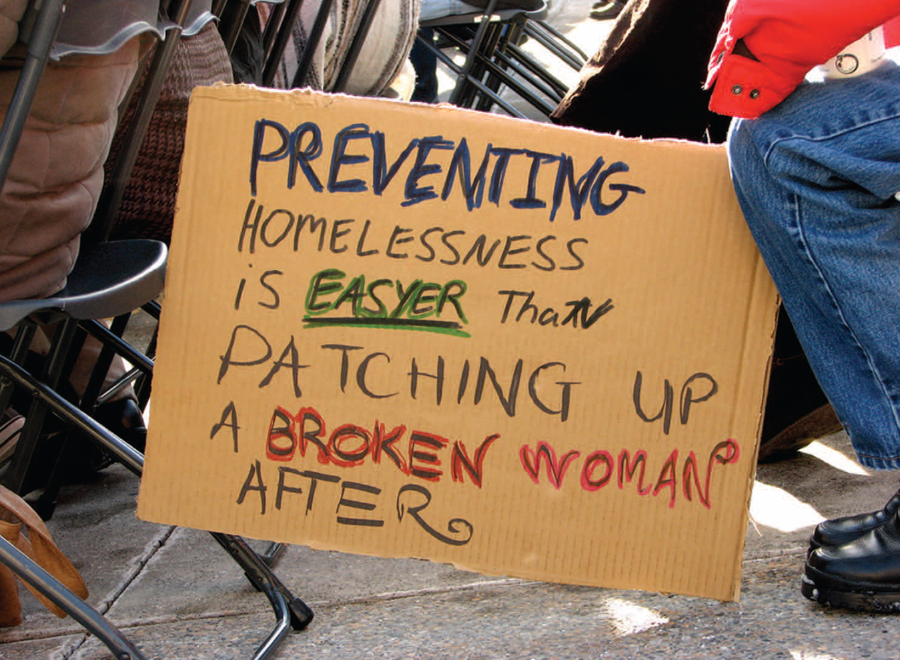In the heart of the nation’s capital, a young homeless woman named Karen* offers another woman a cigarette in exchange for a quarter. She tells of how she wound up living in a shelter when the boyfriend of the friend whose couch she was sleeping on beat her up repeatedly. “I had to get out of the abuse,” she says, holding up the splint on her finger. “When he broke my finger, I left.”
As she talks, a lanky, dishevelled man inches near. Spinning sharply, Karen bares her teeth at him. “Get outta here!” she hisses. Turning back, she tells me: “I wouldn’t stay here long if I were you. I’m not staying either. It gets rowdy around here if you know what I mean. Watch your back when you leave. Look around. Keep moving. Women gotta keep moving out here.”
You may unsubscribe from any of our newsletters at any time.
In a way, Karen is fortunate: at least she has a place to sleep at night. The shelter where she’s staying turns 1,000 women away each year. “We have 52 beds, and we are full all the time. Women sleep on our three couches, too,” says Sue Garvey, executive director of Ottawa’s Cornerstone/Le Pilier women’s shelter. Though there are fewer knocks on the door these days, that isn’t an indication of lack of need. “The women tell us that they know we are at capacity, so they don’t even bother trying anymore.”
Ottawa isn’t the only city where homeless women have difficulty finding a safe place to sleep at night. Homeless women’s service providers and advocacy groups across the country are reporting a rise in the number of women accessing or trying to access their services — and they’re sounding the alarm. “We didn’t used to have a waiting list for [women’s] beds, but now we do,” says Diana Schwenk, a spokesperson for the Mustard Seed, an organization that responds to the needs of inner-city dwellers in Calgary.
Considering that the first homeless shelters for women in Canada opened less than 40 years ago, the result of Toronto’s last street count is staggering: women make up 26 percent of all homeless people (those staying on the streets and in shelters). A 2008 count in Vancouver concluded that though men still dominate the category, homelessness among women is rising faster. “Most homeless people in Canada are single men,” says Isabelle Gaudreau, a spokesperson for Human Resources and Skills Development Canada. “However, research shows that youth, families and women are the fastest-growing groups in the visibly homeless and at-risk population.”
This trend is actually worse than it seems. Women’s homelessness tends to manifest differently than men’s and poses some different challenges. Yet models for responding to the needs of the homeless have historically been designed for men. Helping Canada’s “new homeless” requires that we define homelessness in a way that encompasses women’s experiences and that we let go of the idea that the homeless are, as parliamentary political and social affairs researcher Lyne Casavant describes the stereotypical image, “a homogenous group of older, alcoholic and vaguely crazy men.”
There are about as many reasons for homelessness as there are homeless people: systemic abuse, childhood trauma, costly housing, inadequate salaries, domestic violence, mental health issues and addiction. The recession is also taking a toll. “We’re seeing a lot of single-parent families, women trying to decide whether to buy baby food or pay the rent,” says Dolores Coutts, director of development for Salvation Army Community Services in Calgary.
While many of the causes and effects of homelessness apply equally to both genders, research indicates that women are more likely than men to cite a breakdown of a relationship and/or violence in a relationship as the reason for their homelessness. Florida-based researchers Jennifer Wesely, James Wright, Jana Jasinski and Elizabeth Mustaim, for example, conclude that one out of every four homeless women is homeless mainly because of her experience with violence. Other experts say that’s a conservative estimate.
Homeless men, on the other hand, more often cite loss of work, discharge from an institution like a prison or a hospital, and substance abuse as causes for their situation.
The difference can be fiscal, too. According to Statistics Canada, women earn 85 cents for every dollar paid to men. Given that women head most single-parent families in Canada, this gap presents enormous challenges. One researcher found that when marriages fall apart, men’s incomes increase slightly while women’s drop by more than 40 percent. Ruth MacDonald of St. John’s, Nfld., for example, was 37 when she suddenly became a homeless mother of three. “For 15 years, my husband was sober,” says MacDonald, now in her 40s. “Then he fell off the wagon. I woke up one morning, didn’t know where I was going to go, but knew I had to take the children and leave. It was no way for them to live.”
When women have no other options but to leave home, they typically do whatever they can to keep a roof over their heads and the heads of their children. At extremes, some women avoid the street: staying in abusive relationships or trading sexual favours for shelter to avoid losing custody of their children. “They often sleep in places that are unsafe, go home with men who are unsafe or sleep on couches,” says Janice Abbott, the executive director of Atira Women’s Resource Society in Vancouver.
MacDonald wound up couch-surfing in various family members’ homes with two of her children, then ages one and four, and sent her eldest child from a previous marriage to live with his father while she scrambled to find a home. She eventually moved her family into a home she describes as a “dilapidated wreck.” Slowly, with the support of extended family, she rebuilt her life. Now she is a community support worker for the St. John’s arm of Vibrant Communities, a Canada-wide initiative to alleviate poverty.
For women who wear out their welcome on couches or flee directly to the streets, the consequences can be violent, and sometimes deadly. A study conducted by Street Health and Sistering, two Toronto-based organizations, found that 37 percent of homeless women in the city had been physically assaulted in the past year, and 21 percent had been sexually assaulted or raped at least once. Another study, conducted by St. Paul University and the University of Ottawa in 2003, found that the average lifespan of a homeless woman in Ottawa is 39 years.
In this sense, Nancy, who appears to be in her 40s or 50s, has already beat the odds. Sitting on a park bench outside the Shepherds of Good Hope shelter in downtown Ottawa, she talks about being released from a hospice for the homeless where she received help for a chronic illness three weeks ago. “I wasn’t one of the dying ones,” says the stringy-haired woman with weathered skin. “I guess I’m lucky.” When asked how she ended up without a home, she wryly echoes the experience of many homeless women: “Got the wrong guys.”
Because women go to extreme measures to avoid risking death on the street or the loss of their children, their experience of homelessness is often overlooked. Those who couch surf like Karen or live in deplorable homes like MacDonald aren’t tallied in street head counts and don’t get registered on the Homeless Individuals and Families Information System (HIFIS). An electronic data management system, HIFIS is used by nearly half of the known shelters in Canada to, among other things, gather data on individuals and families who use shelter services. Yet Julie Hahn, a spokesperson for Human Resources and Skills Development Canada, says that while there are 780 beds available at women’s shelters using the HIFIS system, the number designated for women in unisex shelters isn’t identifiable. “Not all shelters using HIFIS have provided us with that information,” says Hahn.
The hidden nature of women’s homelessness combined with the inability to identify resources available to them causes a host of problems in trying to find solutions. And when funding for services depends heavily on numerical identification of need, numbers — no matter how fluid — count. “There is much at stake politically in counting the homeless,” writes parliamentary researcher Casavant. “Very often human and financial efforts to manage the problem are justified according to head count. Generally speaking, the greater the estimate, the greater the number of services that will be directed to the homeless.”
When women aren’t included in the counts, “the models for helping the homeless and addicted are frequently designed by men, for men,” writes Susan Scott in All Our Sisters: Stories of Homeless Women in Canada. Even definitions can prove to be a problem. While women like Karen and MacDonald couch-surfed and lived in squalid conditions, they don’t fit traditional definitions of homelessness. They do, however, fit the United Nations’ more expansive definition, which states that the homeless aren’t just people without a residence who live on the street or in a shelter, but people who live “without access to shelter that meets the basic criteria considered essential for health and human and social development.”
Stella August, for example, isn’t absolutely homeless. But having a roof over her head means not having food on her plate. At 64, August, who lives in Vancouver, relies on community agencies and churches like First United to eat. “When I count what I’ve got left at the end of the month, there’s not much. Not enough for food,” she says. “But I know I’m not alone. There are places that can help me, and I’ve got the Creator.”
For Janice Abbott, though, trying to tally the homeless misses the point. “Counting the homeless is a bit like nailing jelly to a wall. The reality is that there aren’t enough homes. We waste an inordinate amount of time counting, like we need to know exactly how many people are homeless before we can do anything about it.”
“What I see out on the street shouldn’t be happening in the land of freedom,” says August, who is quick to articulate a solution to the problem. “People need homes, not just a shelter where a whole bunch of people are crammed together.”
Nareem Hashim, project co-ordinator for Women’s Equality Housing Network in Ottawa, explains why so many are echoing a“housing first” approach to addressing homelessness: “You need a home before you can get a job, because you need an address. You need a home before you can get your children back. You need a home in order to leave an abusive situation. You need a home in order to deal with substance abuse.”
Homelessness exacerbates mental illness and can lead to addiction, says Harsha Walia, a project co-ordinator at Vancouver’s Downtown Eastside Women’s Centre. “I know many women who turned to drugs after they became homeless. Crack keeps you awake. Women have to stay awake if they want to survive on the street,” she says.
Shepherds of Good Hope has opened four residences in Ottawa in an effort to provide a continuum of housing support. One residence, for example, is staffed 24 hours a day, while another is geared toward residents who need minimum support. “Our goal is to help people make the transition to independent living,” says executive director Paul Soucie.
But there have been road blocks. “The community association protested when we opened one of the residences,” he says. Not-in-my-backyard attitudes have always been challenging.”
Sheri Lecker, the executive director of Adsum House, a women’s shelter in Newfoundland, feels that many Canadians need to change their notions of charity. “It’s like we’ve come to expect people to eat at church halls, like they should patch together what they need in order to survive. There’s no dignity in that,” she says.
In Vancouver, Walia’s voice betrays emotion when she describes the public perception she regularly encounters. “People think [homeless women] are too lazy to get a job or say that they are just junkies or prostitutes. But a woman maybe was abused and had to go onto the street to survive. When she got on the street, her children were taken away. She became depressed. In order to survive, she turned to drugs, or maybe she hasn’t lost her children but has had to enter the sex trade to put a roof over their heads. People need to see the real issues.”
Back in the nation’s capital, it’s noon. Cars are whipping down King Edward Street, and exhaust fumes foul the air. On a patch of grass beside the curb, Debbie picks at the hole in her acid-wash jeans. She’s 23, homeless and has been addicted to crack since she was 18. She has seen her daughter only once. When asked what people can do to help her, she shrugs and begins to pick at the grass, twirling the blades in her finger. “They can see me,” she finally whispers. “Like I’m here or something.”
* Names and identifying details have been changed.
***
This story first appeared in The United Church Observer’s September 2009 issue with the title “No place for a woman.”














